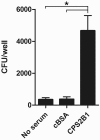Development of capsular polysaccharide-based glycoconjugates for immunization against melioidosis and glanders
- PMID: 22912938
- PMCID: PMC3419357
- DOI: 10.3389/fcimb.2012.00108
Development of capsular polysaccharide-based glycoconjugates for immunization against melioidosis and glanders
Abstract
Burkholderia pseudomallei and Burkholderia mallei, the etiologic agents of melioidosis and glanders, respectively, cause severe disease in humans and animals and are considered potential agents of biological warfare and terrorism. Diagnosis and treatment of infections caused by these pathogens can be challenging and, in the absence of chemotherapeutic intervention, acute disease is frequently fatal. At present, there are no human or veterinary vaccines available for immunization against these emerging/re-emerging infectious diseases. One of the long term objectives of our research, therefore, is to identify and characterize protective antigens expressed by B. pseudomallei and B. mallei and use them to develop efficacious vaccine candidates. Previous studies have demonstrated that the 6-deoxy-heptan capsular polysaccharide (CPS) expressed by these bacterial pathogens is both a virulence determinant and a protective antigen. Consequently, this carbohydrate moiety has become an important component of the various subunit vaccines that we are currently developing in our laboratory. In the present study, we describe a reliable method for isolating CPS antigens from O-polysaccharide (OPS) deficient strains of B. pseudomallei; including a derivative of the select agent excluded strain Bp82. Utilizing these purified CPS samples, we also describe a simple procedure for covalently linking these T-cell independent antigens to carrier proteins. In addition, we demonstrate that high titer IgG responses can be raised against the CPS component of such constructs. Collectively, these approaches provide a tangible starting point for the development of novel CPS-based glycoconjugates for immunization against melioidosis and glanders.
Keywords: Burkholderia mallei; Burkholderia pseudomallei; capsular polysaccharide; glycoconjugate; immunization; vaccine.
Figures






Similar articles
-
Development of novel O-polysaccharide based glycoconjugates for immunization against glanders.Front Cell Infect Microbiol. 2012 Nov 27;2:148. doi: 10.3389/fcimb.2012.00148. eCollection 2012. Front Cell Infect Microbiol. 2012. PMID: 23205347 Free PMC article.
-
Burkholderia pseudomallei capsular polysaccharide conjugates provide protection against acute melioidosis.Infect Immun. 2014 Aug;82(8):3206-13. doi: 10.1128/IAI.01847-14. Epub 2014 May 27. Infect Immun. 2014. PMID: 24866807 Free PMC article.
-
Recombinant Salmonella Expressing Burkholderia mallei LPS O Antigen Provides Protection in a Murine Model of Melioidosis and Glanders.PLoS One. 2015 Jul 6;10(7):e0132032. doi: 10.1371/journal.pone.0132032. eCollection 2015. PLoS One. 2015. PMID: 26148026 Free PMC article.
-
Development of Burkholderia mallei and pseudomallei vaccines.Front Cell Infect Microbiol. 2013 Mar 11;3:10. doi: 10.3389/fcimb.2013.00010. eCollection 2013. Front Cell Infect Microbiol. 2013. PMID: 23508691 Free PMC article. Review.
-
Burkholderia pseudomallei and Burkholderia mallei vaccines: Are we close to clinical trials?Vaccine. 2017 Oct 20;35(44):5981-5989. doi: 10.1016/j.vaccine.2017.03.022. Epub 2017 Mar 21. Vaccine. 2017. PMID: 28336210 Review.
Cited by
-
The autotransporter protein BatA is a protective antigen against lethal aerosol infection with Burkholderia mallei and Burkholderia pseudomallei.Vaccine X. 2018 Dec 22;1:100002. doi: 10.1016/j.jvacx.2018.100002. eCollection 2019 Apr 11. Vaccine X. 2018. PMID: 33826684 Free PMC article.
-
Outer Membrane Vesicle Vaccines from Biosafe Surrogates Prevent Acute Lethal Glanders in Mice.Vaccines (Basel). 2018 Jan 10;6(1):5. doi: 10.3390/vaccines6010005. Vaccines (Basel). 2018. PMID: 29320408 Free PMC article.
-
Impact of Binge Alcohol Intoxication on the Humoral Immune Response during Burkholderia spp. Infections.Microorganisms. 2019 May 9;7(5):125. doi: 10.3390/microorganisms7050125. Microorganisms. 2019. PMID: 31075819 Free PMC article.
-
Development of Subunit Vaccines That Provide High-Level Protection and Sterilizing Immunity against Acute Inhalational Melioidosis.Infect Immun. 2017 Dec 19;86(1):e00724-17. doi: 10.1128/IAI.00724-17. Print 2018 Jan. Infect Immun. 2017. PMID: 29109172 Free PMC article.
-
Structural characterisation of the capsular polysaccharide expressed by Burkholderia thailandensis strain E555:: wbiI (pKnock-KmR) and assessment of the significance of the 2-O-acetyl group in immune protection.Carbohydr Res. 2017 Nov 27;452:17-24. doi: 10.1016/j.carres.2017.09.011. Epub 2017 Sep 21. Carbohydr Res. 2017. PMID: 29024844 Free PMC article.
References
-
- Atkins T., Prior R. G., Mack K., Russell P., Nelson M., Oyston P. C., Dougan G., Titball R. W. (2002). A mutant of Burkholderia pseudomallei, auxotrophic in the branched chain amino acid biosynthetic pathway, is attenuated and protective in a murine model of melioidosis. Infect. Immun. 70, 5290–5294 10.1128/IAI.70.9.5290-5294.2002 - DOI - PMC - PubMed
-
- AuCoin D. P., Reed D. E., Marlenee N. L., Bowen R. A., Thorkildson P., Judy B. M., Torres A. G., Kozel T. R. (2012). Polysaccharide specific monoclonal antibodies provide passive protection against intranasal challenge with Burkholderia pseudomallei. PLoS ONE 7:e35386 10.1371/journal.pone.0035386 - DOI - PMC - PubMed
Publication types
MeSH terms
Substances
Grants and funding
LinkOut - more resources
Full Text Sources
Other Literature Sources
Molecular Biology Databases

